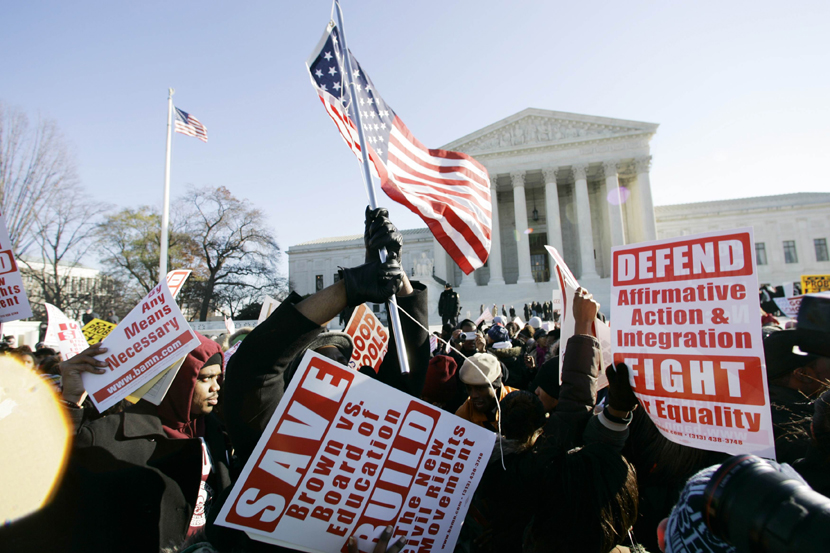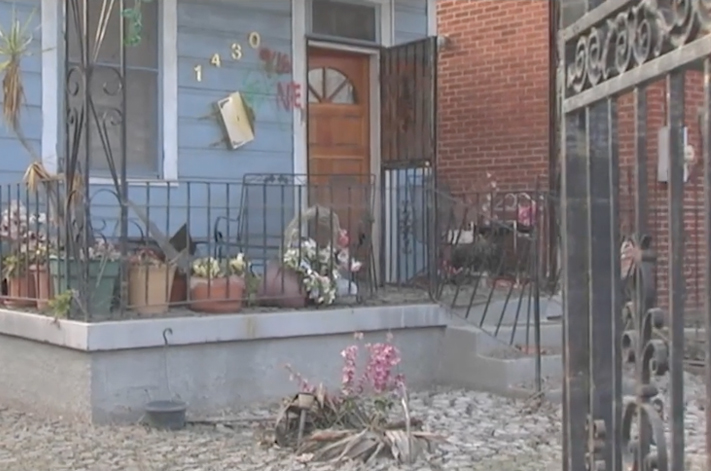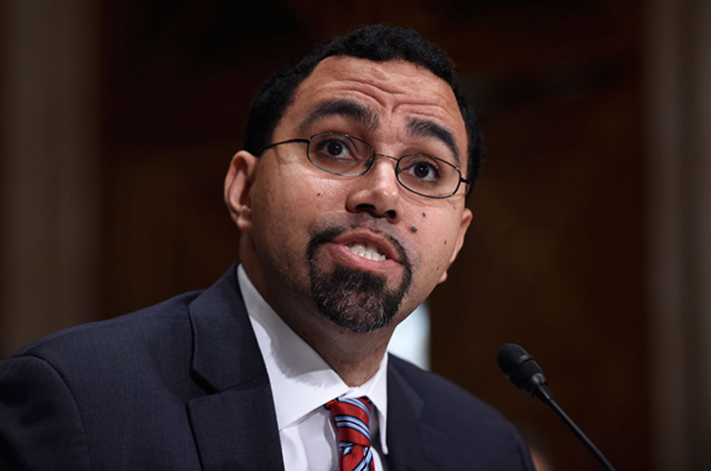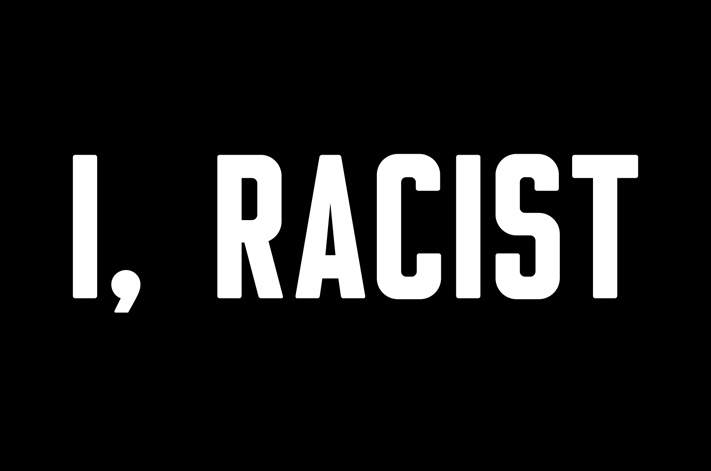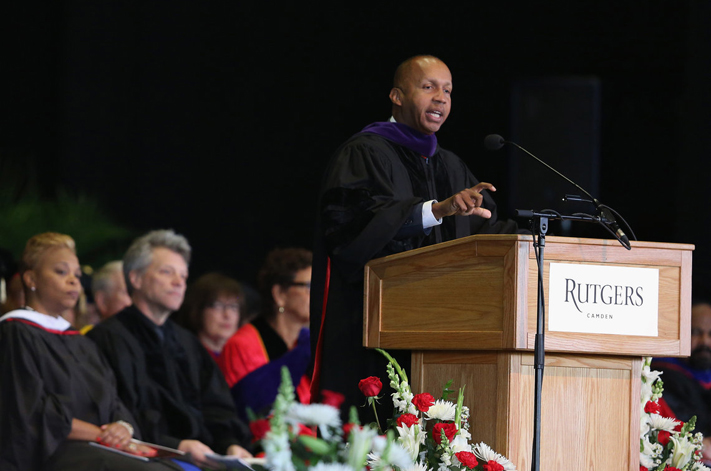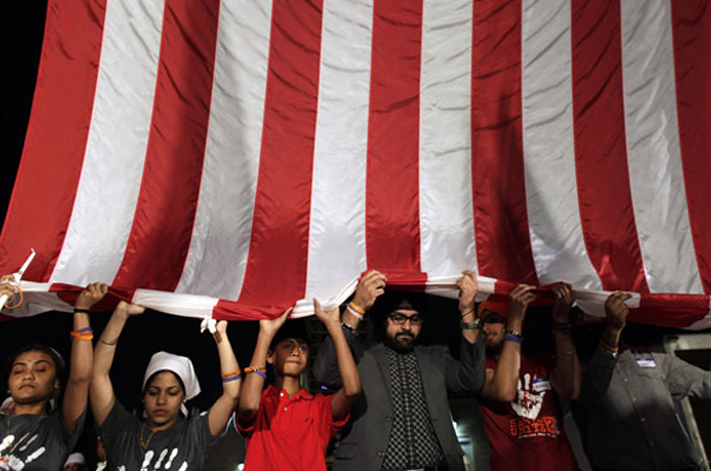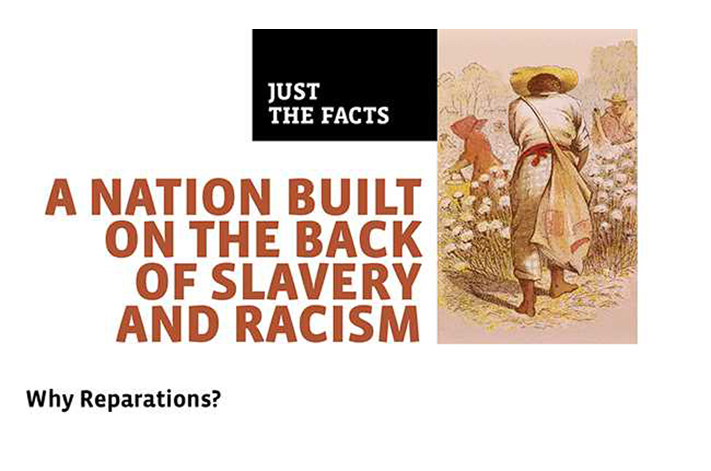Project Description
'We cannot substantially improve the performance of the poorest African American students – the “truly disadvantaged,” in William Julius Wilson’s phrase – by school reform alone.'
Abstract
i.
There are two aspects to this conclusion:
- First, social and economic disadvantage – not poverty itself, but a host of associated conditions – depresses student performance, and
- Second, concentrating students with these disadvantages in racially and economically homogenous schools depresses it further.
- With less access to routine and preventive health care, disadvantaged children have greater absenteeism (Aysola, Orav, & Ayanian, 2011; Starfield, 1997), and they can’t benefit from good schools if they are not present.
- With less literate parents, they are read to less frequently when young, and are exposed to less complex language at home (Ayoub et al., 2009; Brooks-Gunn & Markman, 2005).
- With less adequate housing, they rarely have quiet places to study and may move more frequently, changing schools and teachers (Mehana & Reynolds, 2004; Raudenbush, Jean, & Art, 2011).
- With fewer opportunities for enriching after-school and summer activities, their background knowledge and organizational skills are less developed (Entwisle, Alexander, & Olson, 2000; Neuman & Celano, 2001).
- With fewer family resources, their college ambitions are constrained (Johnson, In Progress).
When a school’s proportion of students at risk of failure grows, the consequences of disadvantage are exacerbated.
In schools with high proportions of disadvantaged children,
- Remediation becomes the norm, and teachers have little time to challenge those exceptional students who can overcome personal, family, and community hardships that typically interfere with learning.
- In schools with high rates of student mobility, teachers spend more time repeating lessons for newcomers, and have fewer opportunities to adapt instruction to students’ individual strengths and weaknesses.
- When classrooms fill with students who come to school less ready to learn, teachers must focus more on discipline and less on learning.
- Children in impoverished neighborhoods are surrounded by more crime and violence and suffer from greater stress that interferes with learning (Buka, Stichick, Birdthistle, & Earls, 2001; Burdick-Will et al., 2010; Farah et al., 2006).
- Children with less exposure to mainstream society are less familiar with the standard English that’s necessary for their future success (Sampson, Sharkey, & Raudenbush, 2008).
- When few parents have strong educations themselves, schools cannot benefit from parental pressure for higher quality curriculum, children have few college-educated role models to emulate and have few classroom peers whose own families set higher academic standards.
- The share of black students attending schools that are more than 90 percent minority has grown from 34 percent to 39 percent from 1991 to 2011 (Orfield & Frankenberg, 2014, Table 8; Orfield & Lee, 2006, Table 3). In 1991, black students typically attended schools where 35 percent of their fellow students were white; by 2011, it had fallen to 28 percent (Orfield & Frankenberg, 2014, Table 4; Orfield, Kucsera, & Siegel-Hawley, 2012, Table 5).
- In 1988, black students typically attended schools in which 43 percent of their fellow students were low-income; by 2006 it had risen to 59 percent (Orfield, 2009).
- In cities with the most struggling students, the isolation is even more extreme. The most recent data show, for example, that in Detroit, the typical black student attends a school where 3 percent of students are white, and 84 percent are low income (Detroit Public Schools, 2009, Enrollment Demographics as of 11/19/2009).
This school segregation mostly reflects neighborhood segregation. In urban areas, low-income white students are more likely to be integrated into middle-class neighborhoods and less likely to attend school predominantly with other disadvantaged students. Although immigrant low-income Hispanic students are also concentrated in schools, by the third generation their families are more likely to settle in more middle-class neighborhoods. Illustrative is that Latino immigrants who had resided in California for at least 30 years had a 65 percent homeownership rate prior to the burst of the housing bubble (Myers, 2008).
1
The racial segregation of schools has been intensifying because the segregation of neighborhoods has been intensifying. Analyzing Census data, Rutgers University Professor Paul Jargowsky has found that in 2011, 7 percent of poor whites lived in high poverty neighborhoods, where more than 40 percent of the residents are poor, up from 4 percent in 2000; 15 percent of poor Hispanics lived in such high poverty neighborhoods in 2011, up from 14 percent in 2000; and a breathtaking 23 percent of poor blacks lived in high poverty neighborhoods in 2011, up from 19 percent in 2000 (Jargowsky, 2013).
In his 2013 book, Stuck in Place (2013), the New York University sociologist Patrick Sharkey defines a poor neighborhood as one where 20 percent of the residents are poor, not 40 percent as in Paul Jargowsky’s work. A 20-percent-poor neighborhood is still severely disadvantaged. In such a neighborhood, many, if not most other residents are likely to have very low incomes, although not so low as to be below the official poverty line.
Sharkey finds that young African Americans (from 13 to 28 years old) are now ten times as likely to live in poor neighborhoods, defined in this way, as young whites—66 percent of African Americans, compared to 6 percent of whites (Sharkey, 2013, p. 27, Fig. 2.1). What’s more, for black families, mobility out of such neighborhoods is much more limited than for whites. Sharkey shows that 67 percent of African American families hailing from the poorest quarter of neighborhoods a generation ago continue to live in such neighborhoods today. But only 40 percent of white families who lived in the poorest quarter of neighborhoods a generation ago still do so (Sharkey, 2013, p. 38, Fig. 2.6).
Considering all black families, 48 percent have lived in poor neighborhoods over at least two generations, compared to 7 percent of white families (Sharkey, 2013, p. 39). If a child grows up in a poor neighborhood, moving up and out to a middle-class area is typical for whites but an aberration for blacks. Black neighborhood poverty is thus more multigenerational while white neighborhood poverty is more episodic; black children in low-income neighborhoods are more likely than others to have parents who also grew up in such neighborhoods.
The implications for children’s chances of success are dramatic: For academic performance, Sharkey uses a scale like the familiar IQ measure, where 100 is the mean and roughly 70 percent of children score about average, between 85 and 115. Using a survey that traces individuals and their offspring since 1968, Sharkey shows that children who come from middle-class (non-poor) neighborhoods and whose mothers also grew up in middle-class neighborhoods score an average of 104 on problem-solving tests. Children from poor neighborhoods whose mothers also grew up in poor neighborhoods score lower, an average of 96.
Sharkey’s truly startling finding, however, is this: Children in poor neighborhoods whose mothers grew up in middle-class neighborhoods score an average of 102, slightly above the mean and only slightly below the average scores of children whose families lived in middle-class neighborhoods for two generations. But children who live in middle-class neighborhoods—yet whose mothers grew up in poor neighborhoods—score an average of only 98 (Sharkey 2013, p. 130, Fig. 5.5.).
Sharkey concludes that “the parent’s environment during [her own] childhood may be more important than the child’s own environment.” He calculates that “living in poor neighborhoods over two consecutive generations reduces children’s cognitive skills by roughly eight or nine points … roughly equivalent to missing two to four years of schooling” (Sharkey 2013, pp. 129-131).
Integrating disadvantaged black students into schools where more privileged students predominate can narrow the black-white achievement gap. Evidence is especially impressive for long term outcomes for adolescents and young adults who have attended integrated schools (e.g., Guryan, 2001; Johnson, 2011). But the conventional wisdom of contemporary education policy notwithstanding, there is no evidence that segregated schools with poorly performing students can be “turned around” while remaining racially isolated. Claims that some schools, charter schools in particular, “beat the odds” founder upon close examination. Such schools are structurally selective on non-observables, at least, and frequently have high attrition rates (Rothstein, 2004, pp. 61-84). In some small districts, or in areas of larger districts where ghetto and middle class neighborhoods adjoin, school integration can be accomplished by devices such as magnet schools, controlled choice, and attendance zone manipulations. But for African American students living in the ghettos of large cities, far distant from middle class suburbs, the racial isolation of their schools cannot be remedied without undoing the racial isolation of the neighborhoods in which they are located.
ii.
The Myth of De Facto Segregation
In Roberts’ terminology, commonly accepted by policymakers from across the political spectrum, constitutionally forbidden segregation established by federal, state or local government action is de jure, while racial isolation independent of state action, as, in Roberts’ view, in Louisville and Seattle, is de facto.
It is generally accepted today, even by sophisticated policymakers, that black students’ racial isolation is now de facto, with no constitutional remedy – not only in Louisville and Seattle, but in all metropolitan areas, North and South.
Even the liberal dissenters in the Louisville-Seattle case, led by Justice Stephen Breyer, agreed with this characterization. Breyer argued that school districts should be permitted voluntarily to address de facto racial homogeneity, even if not constitutionally required to do so. But he accepted that for the most part, Louisville and Seattle schools were not segregated by state action and thus not constitutionally required to desegregate.
This is a dubious proposition. Certainly, Northern schools have not been segregated by policies assigning blacks to some schools and whites to others – at least not since the 1940s; they are segregated because their neighborhoods are racially homogenous.
But neighborhoods did not get that way from “innocent private decisions” or, as the late Justice Potter Stewart once put it, from “unknown and perhaps unknowable factors such as in-migration, birth rates, economic changes, or cumulative acts of private racial fears” (Milliken v. Bradley, 1974).
In truth, residential segregation’s causes are both knowable and known – twentieth century federal, state and local policies explicitly designed to separate the races and whose effects endure today. In any meaningful sense, neighborhoods and in consequence, schools, have been segregated de jure. The notion of de facto segregation is a myth, although widely accepted in a national consensus that wants to avoid confronting our racial history.
iii.
De Jure Residential Segregation by Federal, State, and Local Government
From its New Deal inception and especially during and after World War II, federally funded public housing was explicitly racially segregated, both by federal and local governments. Not only in the South, but in the Northeast, Midwest, and West, projects were officially and publicly designated either for whites or for blacks. Some projects were “integrated” with separate buildings designated for whites or for blacks. Later, as white families left the projects for the suburbs, public housing became overwhelmingly black and in most cities was placed only in black neighborhoods, explicitly so. This policy continued one originating in the New Deal, when Harold Ickes, President Roosevelt’s first public housing director, established the “neighborhood composition rule” that public housing should not disturb the pre-existing racial composition of neighborhoods where it was placed (Hirsch, 1998/1983, p. 14; Hirsch, 2000, p. 209; e.g., Hills v. Gautreaux, 1976; Rothstein, 2012). This was de jure segregation.
Once the housing shortage eased and material was freed for post-World War II civilian purposes, the federal government subsidized relocation of whites to suburbs and prohibited similar relocation of blacks. Again, this was not implicit, not mere “disparate impact,” but racially explicit policy. The Federal Housing and Veterans Administrations recruited a nationwide cadre of mass-production builders who constructed developments on the East Coast like the Levittowns in Long Island, Pennsylvania, New Jersey, and Delaware; on the West Coast like Lakewood and Panorama City in the Los Angeles area, Westlake (Daly City) in the San Francisco Bay Area, and several Seattle suburbs developed by William and Bertha Boeing; and in numerous other metropolises in between. These builders received federal loan guarantees on explicit condition that no sales be made to blacks and that each individual deed include a prohibition on re-sales to blacks, or to what the FHA described as an “incompatible racial element” (FHA, 1938; Jackson, 1985, pp. 207-209, 238; e.g., Silva, 2009). This was de jure segregation.
In addition to guaranteeing construction loans taken out by mass production suburban developers, the FHA, as a matter of explicit policy, also refused to insure individual mortgages for African Americans in white neighborhoods, or even to whites in neighborhoods that the FHA considered subject to possible integration in the future (Hirsch, 2000, pp. 208, 211-212). This was de jure segregation.
Although a 1948 Supreme Court ruling barred courts from enforcing racial deed restrictions, the restrictions themselves were deemed lawful for another 30 years and the FHA knowingly continued, until the Fair Housing Act was passed in 1968, to finance developers who constructed suburban developments that were closed to African-Americans (Hirsch, 2000, pp. 211-212). This was de jure segregation.

Levittown; An Ariel View Provides Perspective
Bank regulators from the Federal Reserve, Comptroller of the Currency, Office of Thrift Supervision, and other agencies knowingly approved “redlining” policies by which banks and savings institutions refused loans to black families in white suburbs and even, in most cases, to black families in black neighborhoods – leading to the deterioration and ghettoization of those neighborhoods (see, e.g., USCCR, 1961, pp. 36-37, 42-51). This was de jure segregation.
Although specific zoning rules assigning blacks to some neighborhoods and whites to others were banned by the Supreme Court in 1917, explicit racial zoning in some cities was enforced until the 1960s. The Court’s 1917 decision was not based on equal protection but on the property rights of white owners to sell to whomever they pleased. Several large cities interpreted the ruling as inapplicable to their racial zoning laws because they prohibited only residence of blacks in white neighborhoods, not ownership. Some cities, Miami the most conspicuous example, continued to include racial zones in their master plans and issued development permits accordingly, even though neighborhoods themselves were not explicitly zoned for racial groups (Mohl, 1987; Mohl, 2001). This was de jure segregation.
In other cities, following the 1917 Supreme Court decision, mayors and other public officials took the lead in organizing homeowners associations for the purpose of enacting racial deed restrictions. Baltimore is one example where the mayor organized a municipal Committee on Segregation to maintain racial zones without an explicit ordinance that would violate the 1917 decision (Power, 1986; Power, 2004). This was de juresegregation.
In the 1980s, the Internal Revenue Service revoked the tax-exemption of Bob Jones University because it prohibited interracial dating. The IRS believed it was constitutionally required to refuse a tax subsidy to a university with racist practices. Yet the IRS never challenged the pervasive use of tax-favoritism by universities, churches, and other non-profit organizations and institutions to enforce racial segregation. The IRS extended tax exemptions not only to churches where such associations were frequently based and whose clergy were their officers, but to the associations themselves, although their racial purposes were explicit and well-known. This was de jure segregation.
Churches were not alone in benefitting from unconstitutional tax exemptions. Robert Hutchins, known to educators for reforms elevating the liberal arts in higher education, was president and chancellor of the tax-exempt University of Chicago from 1929 to 1951. He directed the University to sponsor neighborhood associations to enforce racially restrictive deeds in its nearby Hyde Park and Kenwood neighborhoods, and employed the University’s legal department to evict black families who moved nearby in defiance of his policy, all while the University was subsidized by the federal government by means of its tax-deductible and tax-exempt status (Hirsch, 1998/1983, pp. 144-145; Plotkin 1999, pp. 122-125). This was de jure segregation.
Urban renewal programs of the mid-twentieth century often had similarly undisguised purposes: to force low-income black residents away from universities, hospital complexes, or business districts and into new ghettos. Relocation to stable and integrated neighborhoods was not provided; in most cases, housing quality for those whose homes were razed was diminished by making public housing high-rises or overcrowded ghettos the only relocation option (Hirsch, 2000, pp. 217-222; Weaver, 1948, p. 324, USCCR, 1961, p. 96). This was de jure segregation.
Where integrated or mostly-black neighborhoods were too close to white communities or central business districts, interstate highways were routed by federal and local officials to raze those neighborhoods for the explicit purpose of relocating black populations to more distant ghettos or of creating barriers between white and black neighborhoods. Euphemisms were thought less necessary then than today: according to the director of the American Association of State Highway Officials whose lobbying heavily influenced the interstate program, “some city officials expressed the view in the mid-1950’s that the urban Interstates would give them a good opportunity to get rid of the local ‘niggertown’” (Schwartz, 1976, p. 485 n. 481). This was de jure segregation.
For a sense of how federal policy was infused with segregationist impulses, consider the 1949 Congressional debate over President Harry S Truman’s proposal for a massive public housing program. Conservative Republicans, opposed to federal involvement in the private housing market, devised a “poison pill” guaranteed to defeat the plan. They introduced amendments in the House and Senate requiring that public housing be operated in a non-segregated manner, knowing that if such amendments were adopted, public housing would lose its Southern Democratic support and the entire program would go down to defeat.
The Senate floor leader of the housing program was the body’s most liberal member, Paul Douglas, a former economist at the University of Chicago. Supported by other leading liberal legislators (Senator Hubert Humphrey from Minnesota, for example), Senator Douglas appealed on the floor of the Senate to his fellow Democrats and civil rights leaders, beseeching them to defeat the pro-integration amendment: “I should like to point out to my Negro friends what a large amount of housing they will get under this act… I am ready to appeal to history and to time that it is in the best interests of the Negro race that we carry through the housing program as planned, rather than put in the bill an amendment which will inevitably defeat it…”
The Senate and House each then considered and defeated proposed amendments that would have prohibited segregation and racial discrimination in federally funded public housing programs, and the 1949 Housing Act, with its provisions for federal finance of public housing, was adopted (Davies, 1966, p. 108; Julian & Daniel, 1989, pp. 668-669). It permitted local authorities in the North as well as the South to design separate public housing projects for blacks and whites, or to segregate blacks and whites within projects. And they did so.
Although there was an enormous national housing shortage at the time, one that denied millions of African Americans a decent place to live, it remains an open question whether it really was in their best interests to be herded into segregated projects, where their poverty was concentrated and isolated from the American mainstream.
It was not, however, federal policy alone that segregated the metropolitan landscape. State policy contributed as well.
Real estate is a highly regulated industry. State governments require brokers to take courses in ethics and exams to keep their licenses. State commissions suspend or even lift licenses for professional and personal infractions – from mishandling escrow accounts to failing to pay personal child support. But although real estate agents openly enforced segregation, state authorities did not punish brokers for racial discrimination, and rarely do so even today when racial steering and discriminatory practices remain (Galster & Godfrey, 2005). This misuse of regulatory authority was, and is, de jure segregation.
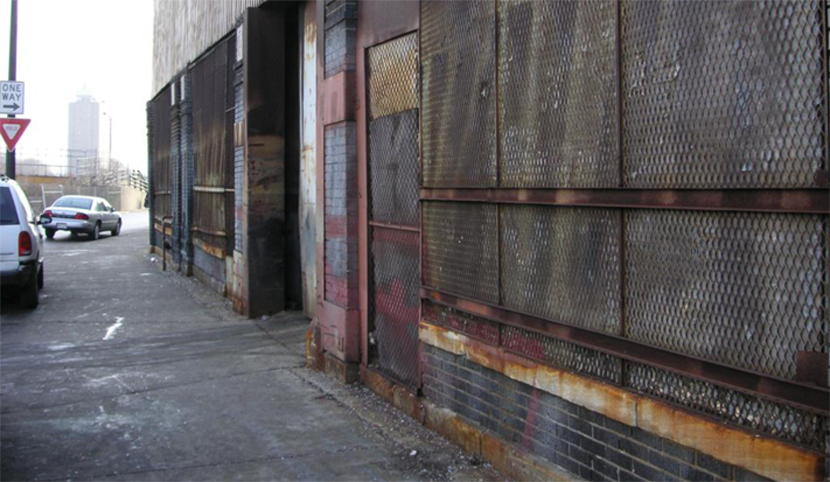
Erick Allix Rogers for Chicago From Home To School: Why Segregation Persists And Current Reforms May Only Make Things Worse
Local officials also played roles in violation of their constitutional obligations. Public police and prosecutorial power was used nationwide to enforce racial boundaries. Illustrations are legion. In the Chicago area, police forcibly evicted blacks who moved into an apartment in a white neighborhood; in Louisville, the locus of Parents Involved, the state prosecuted and convicted (later reversed) a white seller for sedition after he sold his white-neighborhood home to a black family (Braden, 1958). Everywhere, North, South, East, and West, police stood by while thousands (not an exaggeration) of mobs set fire to and stoned homes purchased by blacks in white neighborhoods, and prosecutors almost never charged well-known and easily identifiable mob leaders (Rubinowitz & Perry, 2002). This officially sanctioned abuse of the police power also constituted de jure segregation.
An example from Culver City, a suburb of Los Angeles, illustrates how purposeful state action to promote racial segregation could be. During World War II, its state’s attorney instructed the municipality’s air raid wardens, when they went door-to-door advising residents to turn off lights to avoid providing guidance to Japanese bombers, also to solicit homeowners to sign restrictive covenants barring blacks from residence in the community (“Communiques from the housing front,” 1943). This was de jure segregation.
Other forms abound of racially explicit state action to segregate the urban landscape, in violation of the Fifth, Thirteenth, and Fourteenth Amendments. Yet the term “de facto segregation,” describing a never-existent reality, persists among otherwise well-informed advocates and scholars. The term, and its implied theory of private causation, hobbles our motivation to address de jure segregation as explicitly as Jim Crow was addressed in the South or apartheid was addressed in South Africa.
Private prejudice certainly played a very large role. But even here, unconstitutional government action not only reflected but helped to create and sustain private prejudice. In part, white homeowners’ resistance to black neighbors was fed by deteriorating ghetto conditions, sparked by state action. Seeing slum conditions invariably associated with African Americans, white homeowners had a reasonable fear that if African Americans moved into their neighborhoods, these refugees from urban slums would bring the slum conditions with them.
Yet these slum conditions were supported by state action, by overcrowding caused almost entirely by the refusal of the federal government to permit African Americans to expand their housing supply by moving to the suburbs, and by municipalities’ discriminatory denial of adequate public services (Colfax, 2009, Kerner Commission, 1968, pp. 14, 145, 273; Satter, 2009). In the ghetto,
- garbage was collected less frequently,
- predominantly African American neighborhoods were re-zoned for mixed (i.e., industrial, or even toxic) use,
- streets remained unpaved,
- even water, power, and sewer services were less often provided.
iv.
The Continuing Effects of State Sponsored Residential Segregation
This unaffordability was also created by federal, state, and local policy that prevented African Americans in the mid-twentieth century from accumulating the capital needed to invest in home ownership in middle-class neighborhoods, and then from benefiting from the equity appreciation that followed in the ensuing decades.
Federal labor market and income policies were racially discriminatory until only a few decades ago. In consequence, most black families, who in the mid-twentieth century could have joined their white peers in the suburbs, can no longer afford to do so.
The federal civil service was first segregated in the twentieth century, by the administration of President Woodrow Wilson. Under rules then adopted, no black civil servant could be in a position of authority over white civil servants, and in consequence, African Americans were restricted and demoted to the most poorly paid jobs (King, 1995).
The federal government recognized separate black and white government employee unions well into the second half of the twentieth century. For example, black letter carriers were not admitted to membership in the white postal service union. Black letter carriers had their own union but the Postal Service would only hear grievances from the white organization (“Same work, different unions,” 2011).
At the behest of Southern segregationist Senators and Congressmen, New Deal labor standards laws, like the National Labor Relations Act and the minimum wage law, excluded from coverage, for undisguised racial purposes, occupations in which black workers predominated (Katznelson, 2013).
The National Labor Relations Board certified segregated private sector unions, and unions that entirely excluded African Americans from their trades, into the 1970s (Foner, 1976; Hill, 1977; Independent Metal Workers, 1964).
State and local governments maintained separate, and lower, salary schedules for black public employees through the 1960s (e.g., Rothstein & Miles, 1995).
In these and other ways, government played an important and direct role in depressing the income levels of African American workers below the income levels of comparable white workers. This, too, contributed to the inability of black workers to accumulate the wealth needed to move to equity-appreciating white suburbs.
Today (2010), median black family income is 61 percent of the white median, but black median family wealth (net worth, or assets minus debts) is an astonishingly low 5 percent of the white median (Mishel, Bivens, Gould, & Shierholz, 2012, Tables 2.5 and 6.5). The wealth gap does not only reflect the desperate financial situation of the poorest disadvantaged families. Thomas Shapiro, co-author of Black Wealth/White Wealth (1995), has estimated the relative wealth by race for middle-class families. Calculating relative wealth for black and white families with annual incomes of $60,000—slightly above the national median—from his most recent data in 2007, he found that black middle-class wealth was only 22 percent of whites’ (T. Shapiro, personal communication, May 3, 2014). This gap has undoubtedly widened since 2007 because the housing collapse harmed blacks—who were targeted disproportionately for exploitative subprime loans and exposed to foreclosure—more than whites.
In short, middle-class African Americans and whites are in different financial straits. Total family wealth (including the ability to borrow from home equity) has more impact than income on high-school graduates’ ability to afford college. Wealth also influences children’s early expectations that they will attend and complete college. White middle-class children are more likely to prepare for, apply to, and graduate from college than black children with similar family incomes. This widely acknowledged difference in educational outcomes is, in considerable part, the enduring effect of de jure segregated housing policies of the 20th century, policies that prevented African Americans from accumulating, and bequeathing, wealth that they might otherwise have gained from appreciating real estate.
Levittown, described above as a Long Island suburban development built with federal financing and restricted to whites, illustrates these enduring effects. William Levitt sold his houses to whites in 1947 for $7,000, about two and a half times the national median family income (Jackson, 1985, pp. 231-245; Williamson, 2005). White veterans could get VA or FHA loans with no down payments. Today, these homes typically sell for $400,000, about six times the median income, and FHA loans require 20 percent down. Although African Americans are now permitted to purchase in Levittown, it has become unaffordable. By 2010 Levittown, in a metropolitan region with a large black population, was still less than 1 percent black. White Levittowners can today easily save for college. Blacks denied access to the community are much less likely to be able to do so.
Segregation in many other suburbs is now locked in place by exclusionary zoning laws – requiring large setbacks, prohibiting multi-family construction, or specifying minimum square footage – in suburbs where black families once could have afforded to move in the absence of official segregation, but can afford to do so no longer with property values appreciated.
Mid-twentieth century policies of de jure racial segregation continue to have impact in other ways, as well. A history of state-sponsored violence to keep African Americans in their ghettos cannot help but influence the present-day reluctance of many black families to integrate.
Today, when facially race-neutral housing or redevelopment policies have a disparate impact on African Americans, that impact is inextricably intertwined with the state-sponsored system of residential segregation that we established.
v.
Miseducating Our Youth
But this obligation cannot be fulfilled by school districts alone. As noted above, in some small cities, and in some racial border areas, some racial school integration can be accomplished by adjusting attendance zones, establishing magnet schools, or offering more parent-student choice. This is especially true – but only temporarily – where neighborhoods are in transition, either from gradual urban gentrification, or in first-ring suburbs to which urban ghetto populations are being displaced. These school integration policies are worth pursuing, but generally, our most distressed ghettos are too far distant from truly middle-class communities for school integration to occur without racially explicit policies of residential desegregation. Many ghettos are now so geographically isolated from white suburbs that voluntary choice, magnet schools, or fiddling with school attendance zones can no longer enable many low-income black children to attend predominantly middle class schools (Rothstein & Santow, 2012).
Instead, narrowing the achievement gap will also require housing desegregation, which history also shows is not a voluntary matter but a constitutional necessity – involving policies like voiding exclusionary zoning, placing scattered low and moderate income housing in predominantly white suburbs, prohibiting landlord discrimination against housing voucher holders, and ending federal subsidies for communities that fail to reverse policies that led to racial exclusion.
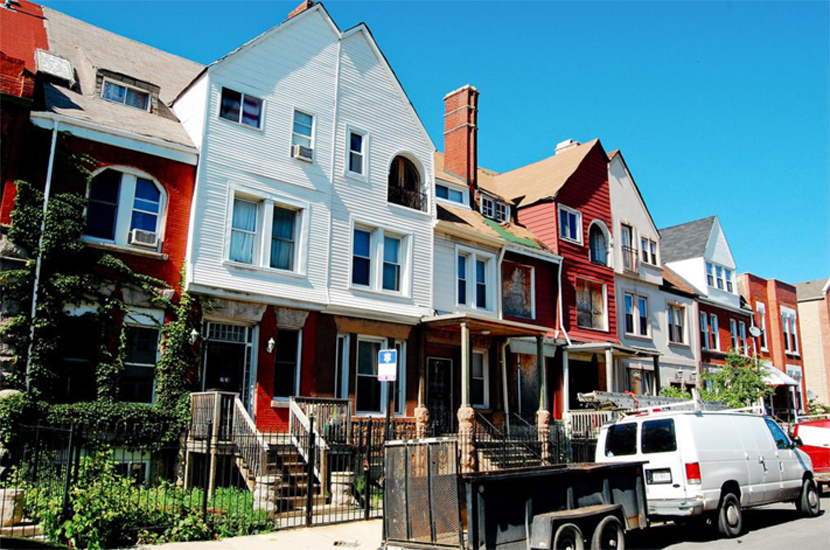
Erick Allix Rogers for Chicago From Home To School: Why Segregation Persists And Current Reforms May Only Make Things Worse
We will never develop the support needed to enact such policies if policymakers and the public are unaware of the history of state-sponsored residential segregation. And we are not doing the job of telling young people this story, so that they will support more integration-friendly policies in the future. Elementary and secondary school curricula typically ignore, or worse, misstate this story. For example,
- In over 1,200 pages of McDougal Littell’s widely used high school textbook, The Americans (2007, p. 494), a single paragraph is devoted to 20th century “Discrimination in the North.” It devotes one passive-voice sentence to residential segregation, stating that “African Americans found themselves forced into segregated neighborhoods,” with no further explanation of how public policy was responsible.
- Another widely used textbook, Prentice Hall’s United States History (2010, pp. 916-917), also attributes segregation to mysterious forces: “In the North, too, African Americans faced segregation and discrimination. Even where there were no explicit laws, de facto segregation, or segregation by unwritten custom or tradition, was a fact of life. African Americans in the North were denied housing in many neighborhoods.”
- History Alive! (2008, p. 423), a popular textbook published by the Teachers’ Curriculum Institute, teaches that segregation was only a Southern problem: “Even New Deal agencies practiced racial segregation, especially in the South,” failing to make any reference to what Ira Katznelson, in his 2013 Fear Itself, describes as FDR’s embrace of residential segregation nationwide in return for Southern support of his economic policies.
References
Ayoub, C., O’Connor, E., Rappolt-Schlictmann, G., Vallotton, C., Raikes, H., & Chazan-Cohen, R. (2009). Cognitive skill performance among young children living in poverty: Risk, change, and the promotive effects of Early Head Start. Early Childhood Research Quarterly, 24(3), 289-305. doi: 10.1016/j.ecresq.2009.04.001
Aysola, J., Orav, E. J., & Ayanian, J. Z. (2011). Neighborhood characteristics associated with access to patient-centered medical homes for children. Health Affairs, 30(11), 2080–2089. doi:10.1377/hlthaff.2011.0656
Braden, A. (1958). The wall between. New York, NY: Monthly Review Press.
Brooks-Gunn, J., & Markman, L. B. (2005). The contribution of parenting to ethnic and racial gaps in school readiness. The future of children, 15(1), 139-168.
Buka, S. L., Stichick, T. L., Birdthistle, I., & Earls, F. J. (2001). Youth exposure to violence:
Prevalence, risks, and consequences. American Journal of Orthopsychiatry, 71(3), 298–310. doi:10.1037/0002-9432.71.3.298
Burdick-Will, J., Ludwig, J., Raudenbush, S. W., Sampson, R. J., Sonbonmatsu, L., & Sharkey, P. (2010). Converging evidence for neighborhood effects on children’s test scores: An experimental, quasi-experimental, and observational comparison. Paper prepared for the Brookings Institution Project on Social Inequality and Educational Disadvantage: New Evidence on How Families, Neighborhoods and Labor Markets Affect Educational Opportunities for American Children. Retrieved from http://cas.uchicago.edu/workshops/education/files/2010/03/Burdick-Will-Ed-Workshop-20100301.pdf
Colfax, R. N. (2009, Fall). Kennedy v. City of Zanesville: Making the case for water. Human Rights, 36(4). American Bar Association. Retrieved from http://www.americanbar.org/publications/human_rights_magazine_home/human_rights_vol36_2009/fall2009/kennedy_v_city_of_zanesville_making_a_case_for_water.html
Communiques from the housing front: Venice race-hate meet reported on. (1943, November 18). California Eagle, 64(32), pp. 1-2. Retrieved from http://www.archive.org/details/la_caleagle_reel26
Danzer, G. A., de Alva J. J. K., Krieger, L. S., Wilson, L. E., & Woloch, N. (2007). The Americans. Evanston, IL: McDougal Littell.
Davies, R. O. (1966). Housing reform during the Truman administration. Columbia, MO: University of Missouri Press.
Detroit Public Schools (2009). Detroit city school district. Retrieved from http://detroitk12.org/schools/reports/profiles/district_profile.pdf
Entwisle, D. R., Alexander, K. L., & Olson, L. S. (2000). Summer learning and home environment. In R. D. Kahlenberg (Ed.), A notion at risk: Preserving public education as an engine for social mobility (pp. 9-30). New York, NY: Century Foundation Press.
Farah, M. J., Shera, D. M., Savage, J. H., Betancourt, L., Giannetta, J. M., Brodsky, N. L., … & Hurt, H. (2006). Childhood poverty: Specific associations with neurocognitive development. Brain Research, 1110(1), 166-174. doi: 10.1016/j.brainres.2006.06.072
FHA (Federal Housing Administration) (1938). Underwriting manual: Underwriting and valuation procedure under Title II of the National Housing Act. Excerpts in J. M. Thomas & M. Ritzdorf (Eds.). (1997). Urban planning and the African American community: In the shadows (pp. 282-284). Thousand Oaks, CA: Sage Publications.
Foner, P. S. (1976). Organized labor and the black worker, 1619-1973. New York, NY: International Publishers.
Galster, G. & Godfrey, E. (2005). By words and deeds: Racial steering by real estate agents in the U.S. in 2000. Journal of the American Planning Association, 71(3), 251-268.
Guryan, J. (2001). Desegregation and black dropout rates. Working Paper 8345, Cambridge, MA: National Bureau of Economic Research.
Hill, H. (1977). Black labor and the American legal system. Washington, DC: Bureau of National Affairs.
Hills v. Gautreaux. 425 U. S. 284 (1976).
Hirsch, A. R. (1998). Making the second ghetto: Race and housing in Chicago, 1940-1960.(Original work published 1983). Chicago, IL: University of Chicago Press.
Hirsch, A. R. (2000). Choosing segregation: Federal housing policy between Shelley and Brown.
In J. F. Bauman, R. Biles, & K. M. Szylvian (Eds.). From tenements to the Taylor Homes: In search of an urban housing policy in twentieth century America (pp. 206-225). University Park, Pennsylvania: The Pennsylvania State University Press.
Independent Metal Workers, Local 1. 147 N.L.R.B. 1573 (1964).
Jackson, K. T. (1985). Crabgrass frontier. New York, NY: Oxford University Press.
Jargowsky, P. A. (2013). Concentration of poverty in the new millennium: Changes in the prevalence, composition, and location of high-poverty neighborhoods. The Century Foundation and Rutgers Center for Urban Research and Education. Retrieved from http://www.tcf.org/assets/downloads/Concentration_of_Poverty_in_the_New_Millennium.pdf
Johnson, R. C. (2011). Long-run impacts of school desegregation & school quality on adult attainments. Cambridge, Massachusetts: Working Paper 16664. Cambridge, MA. National Bureau of Economic Research.
Johnson, R. C. (In Progress). The impact of parental wealth on college enrollment & degree attainment: Evidence from the housing boom & bust. Working Paper, 2012. University of California Berkeley: Goldman School of Public Policy. Retrieved from http://socrates.berkeley.edu/~ruckerj/RJabstract_ParentalWealth_KidCollege_12-11.pdf
Julian, E. K. & Daniel, M. M. (1989). Separate and unequal: The root and branch of public housing segregation. Clearinghouse Review, 23, 666-676.
Katznelson, I. (2013). Fear itself: The New Deal and the origins of our time. New York, NY: Liveright Publishing Corporation.
Kerner Commission (National Advisory Commission on Civil Disorders). (1968). Report of the national Advisory Commission on Civil Disorders. New York, NY: Bantam Books.
King, D. (1995). Separate and unequal: Black Americans and the U.S. federal government. Oxford, England: Clarendon Press.
Lapanksy-Werner, E. L., Levy, P. B., Roberts, R., & Taylor, A. (2010). United States history. Upper Saddle River, NJ: Pearson.
Mehana, M. & Reynolds, A. J. (2004). School mobility and achievement: A meta-analysis. Children and Youth Services Review, 26(1), 93-119. doi: 10.1016/j.childyouth.2003.11.004
Milliken v. Bradley, 418 U.S. 717 (1974).
Mishel, L., Bivens, J., Gould, E., & Shierholz, H. (2012). The state of working America (12thEdition). Washington, DC: The Economic Policy Institute. Retrieved from http://www.stateofworkingamerica.org/subjects/overview/?reader
Mohl, R. A. (1987, Spring). Trouble in paradise: Race and housing in Miami during the New Deal era. Prologue: The Journal of the National Archives, 19(1), 7-21.
Mohl, R. A. (2001). Whitening Miami: Race, housing, and government policy in twentieth-century Dade County. The Florida Historical Quarterly, 79(3), 319-345.
Myers, D. (2008). Immigrants’ contributions in an aging America. Communities and Banking, 19(3), 3-5. Retrieved from http://www.bostonfed.org/commdev/c&b/2008/summer/myers_immigrants_and_boomers.pdf
Neuman, S. B. & Celano, D. (2001). Access to print in low-income and middle income communities: An ecological study of four neighborhoods. Reading Research Quarterly, 36(1), 8-26. doi: 10.1598/RRQ.36.1.1
Orfield, G. (2009). Reviving the goal of an integrated society: A 21st century challenge. Los Angeles, CA: The Civil Rights Project/Proyecto Derechos Civiles. Retrieved from http://civilrightsproject.ucla.edu/research/k-12-education/integration-and-diversity/reviving-the-goal-of-an-integrated-society-a-21st-century-challenge/orfield-reviving-the-goal-mlk-2009.pdf
Orfield, G. & Frankenberg, E. (with Ee, J. & Kuscera, J.). (2014). Brown at 60: Great progress, a long retreat and an uncertain future. Los Angeles, CA: The Civil Rights Project/Proyecto Derechos Civiles. Retrieved from http://civilrightsproject.ucla.edu/research/k-12-education/integration-and-diversity/brown-at-60-great-progress-a-long-retreat-and-an-uncertain-future/Brown-at-60-051814.pdf
Orfield, G., Kucsera, J., & Siegel-Hawley, G. (2012). E pluribus…separation: Deepening double segregation for more students. Los Angeles, CA: The Civil Rights Project/Proyecto Derechos Civiles. Retrieved from http://civilrightsproject.ucla.edu/research/k-12-education/integration-and-diversity/mlk-national/e-pluribus…separation-deepening-double-segregation-for-more-students/orfield_epluribus_revised_omplete_2012.pdf
Orfield, G. & Lee, C. (2006). Racial transformation and the changing nature of segregation. Cambridge, MA: The Civil Rights Project at Harvard University. Retrieved from http://civilrightsproject.ucla.edu/research/k-12-education/integration-and-diversity/racial-transformation-and-the-changing-nature-of-segregation/orfield-racial-transformation-2006.pdf
Parents Involved in Community Schools v. Seattle School Dist. No. 1, 551 U. S. 701 (2007).
Plotkin, W. (1999). Deeds of mistrust: Race, housing, and restrictive covenants in Chicago, 1900-1953. Doctoral Dissertation. Retrieved from Proquest. (9941500)
Power, G. (1986, March). The development of residential Baltimore, 1900-1930. Paper presented at the Chancellor’s Colloquium, University of Maryland at Baltimore.
Power, G. (2004). Meade v. Dennistone: The NAACP’s test case to “…sue Jim Crow out of Maryland with the Fourteenth Amendment.” Maryland Law Review, 63(4), 773-810. Retrieved from http://digitalcommons.law.umaryland.edu/cgi/viewcontent.cgi?article=3230&context=mlr
Raudenbush, S. W., Jean, M., & Art, E. (2011). Year-by-year and cumulative impacts of attending a high-mobility elementary school on children’s mathematics achievement in Chicago, 1995 to 2005. In G. J. Duncan & R. J. Murnane (Eds.), Whither opportunity: Rising inequality, schools, and children’s life chances (pp. 359-376). New York, NY: Russell Sage Foundation.
Rothstein, R. (2004). Class and schools: Using social, economic, and educational reform to close the Black-White Achievement Gap. Washington, D.C. and New York, N.Y.: Economic Policy Institute and Teachers College Press.
Rothstein, R. (2012). Race and public housing: Revisiting the federal role. Poverty and Race,21(6), 1-2; 13-17. Retrieved from http://prrac.org/newsletters/novdec2012.pdf
Rothstein, R., & Miles, K. H. (1995). Where’s the money gone? Changes in the level and composition of education spending. Washington, D.C.: The Economic Policy Institute. Retrieved from http://www.epi.org/page/-/old/books/moneygone.pdf
Rothstein, R., & Santow, M. (2012). A different kind of choice. Working Paper. Washington, D.C.: The Economic Policy Institute. Retrieved from http://www.epi.org/files/2012/Different_Kind_Of_Choice.pdf
Rubinowitz, L. S. & Perry, I. (2002). Crimes without punishment: White neighbors’ resistance to black entry. Journal of Criminal Law and Criminology, 92(2), 335-428.
Same work, different unions: Carriers content with legacy of segregation. (2011, June). Postal Record, 8-13. National Association of Letter Carriers. Retrieved from http://www.nalc.org/news/precord/ArticlesPDF/june2011/06-2011_segregation.pdf
Sampson, R. J., Sharkey, P., & Raudenbush, S. W. (2008). Durable effects of concentrated disadvantage on verbal ability among African-American children. Proceedings of the National Academy of Sciences, 105(3), 845-852. doi: 10.1073/pnas.0710189104
Satter, B. (2009). Family properties: Race, real estate, and the exploitation of black urban America. New York, NY: Metropolitan Books
Schwartz, G. T. (1976). Urban freeways and the interstate system. Southern California Law Review, 49(3), 406-513.
Sharkey, P. (2013). Stuck in place: Urban neighborhoods and the end of progress toward racial equality. Chicago, IL: University of Chicago Press.
Silva, C. (2009). Racial restrictive covenants: Enforcing neighborhood segregation in Seattle. Seattle Civil Rights and Labor History Project, University of Washington. Retrieved from http://depts.washington.edu/civilr/covenants_report.htm
Starfield, B. (1997). Health indicators for preadolescent school-age children. In R. M. Hauser, B. V. Brown, & W. R. Prosser (Eds), Indicators of children’s well-being (pp. 95-111). New York, NY: Russell Sage Foundation.
U.S. Census Bureau (2014). People and households, housing vacancies and homeownership (CPS/HVS), Historical tables. Table 16: Homeownership rates by race and ethnicity of householder:1994 to present. Retrieved June 2, 2014 from http://www.census.gov/housing/hvs/data/histtabs.html
USCCR (United States Commission on Civil Rights) (1961). Book 4: Housing: 1961 Commission on Civil Rights report. Washington, D.C.: Government Printing Office. Retrieved from http://www.law.umaryland.edu/marshall/usccr/documents/cr11961bk4.pdf
Weaver, R. C. (1948). The negro ghetto. New York, NY: Russell & Russell.
Williamson, J. (2005). Retrofitting ‘Levittown’. Places Journal, 17(2), 46-51. Retrieved from http://escholarship.org/uc/item/0r57v5j3
1. Compare to overall national rates in 2007 (in percents): all, 68; whites, 75; blacks, 47; Hispanics (all generations), 50 (U.S. Census Bureau, 2014).
Richard Rothstein is a research associate of the Economic Policy Institute and senior fellow of the Chief Justice Earl Warren Institute on Law and Social Policy at the University of California (Berkeley) School of Law. He is the author of Grading Education: Getting Accountability Right (Teachers College Press and EPI, 2008) and Class and Schools: Using Social, Economic and Educational Reform to Close the Black-White Achievement Gap (Teachers College Press 2004). He is also the author of The Way We Were? Myths and Realities of America’s Student Achievement (1998). Other recent books include The Charter School Dust-Up: Examining the Evidence on Enrollment and Achievement (co-authored in 2005); and All Else Equal: Are Public and Private Schools Different? (co-authored in 2003).
This piece was reprinted by EmpathyEducates with permission or license. Honored, we thank the Author, Richard Rothstein for his kindness, quality research, observations, and enduring efforts to bring equality to fruition.
